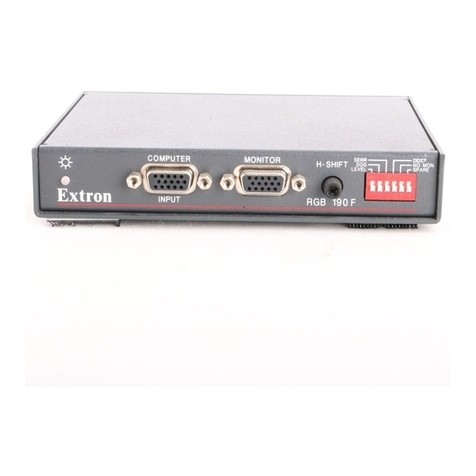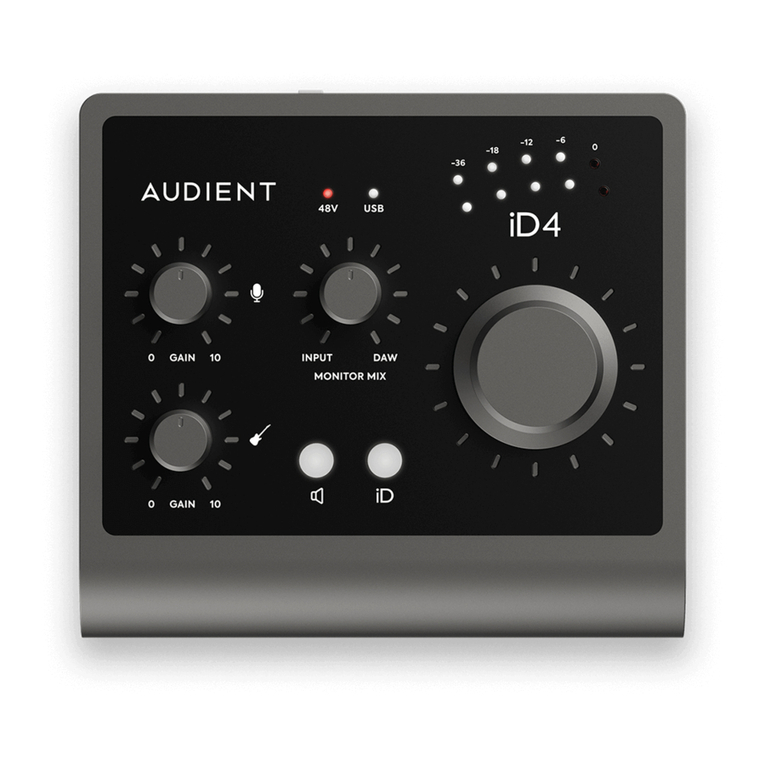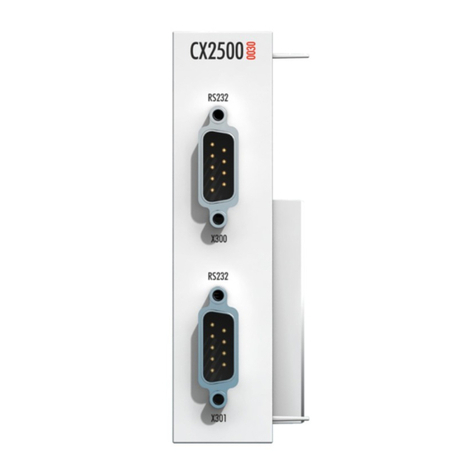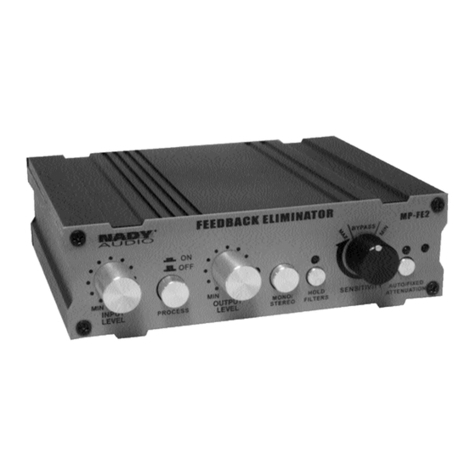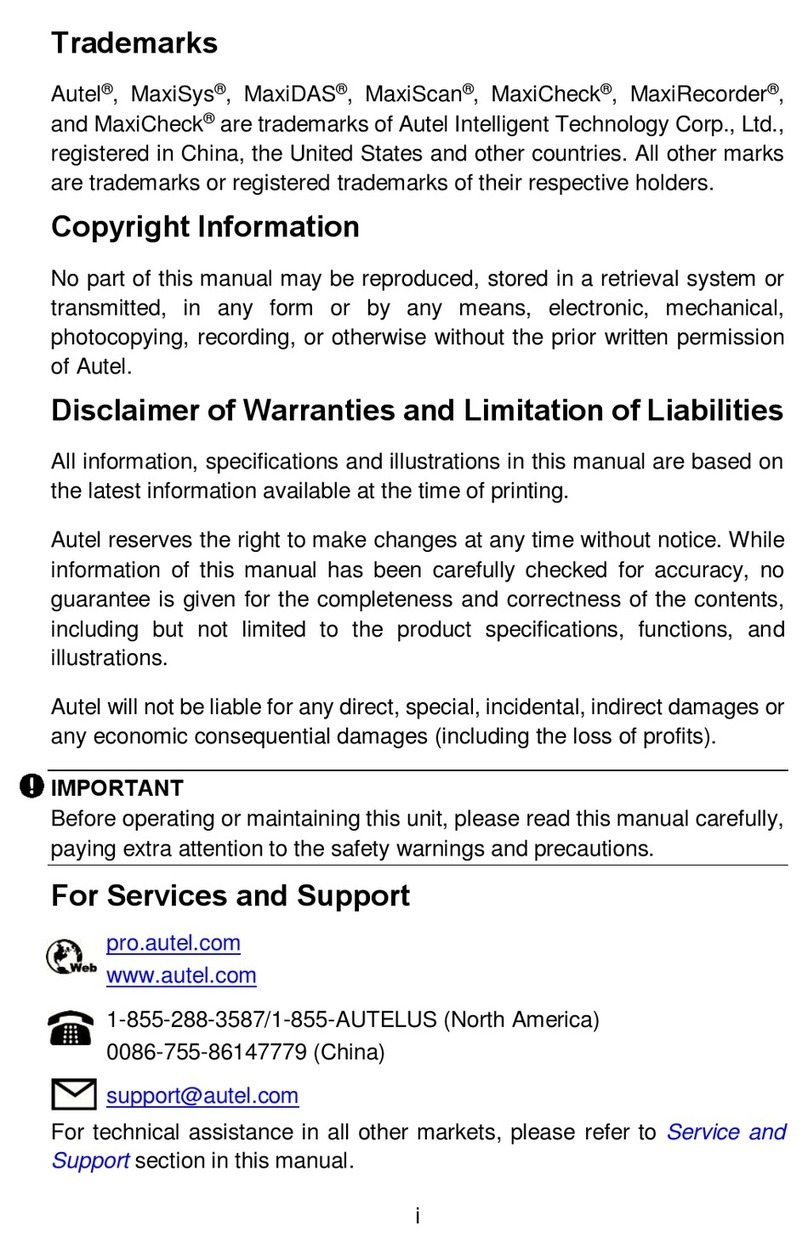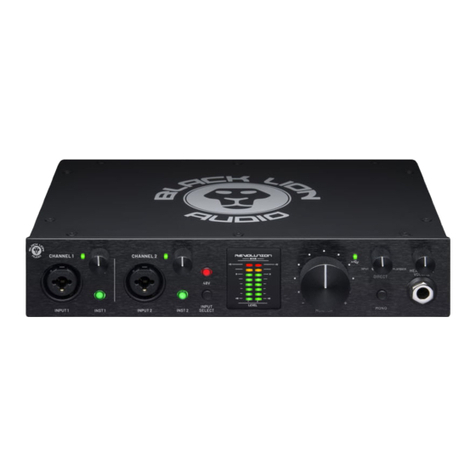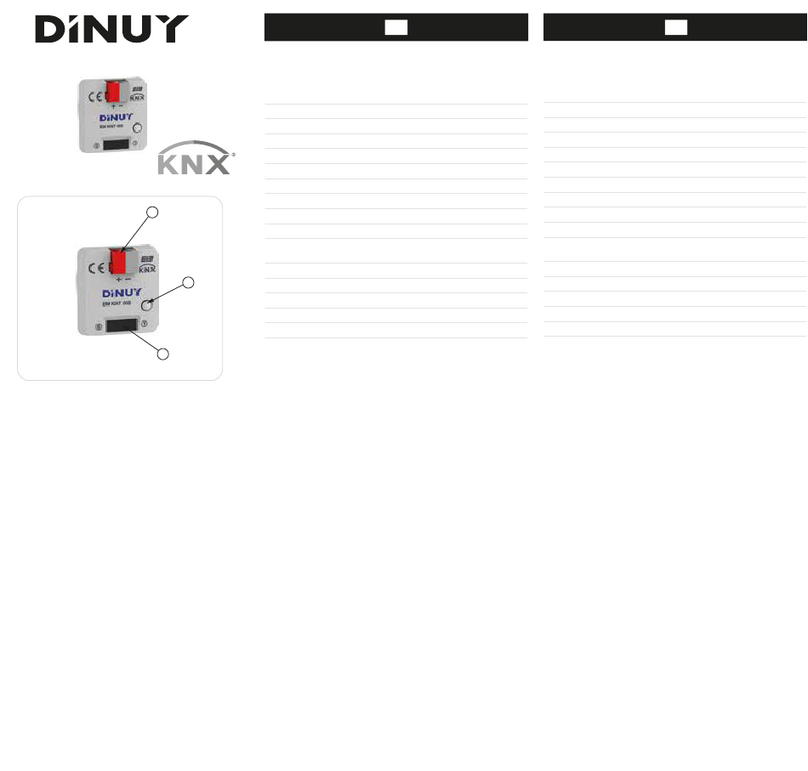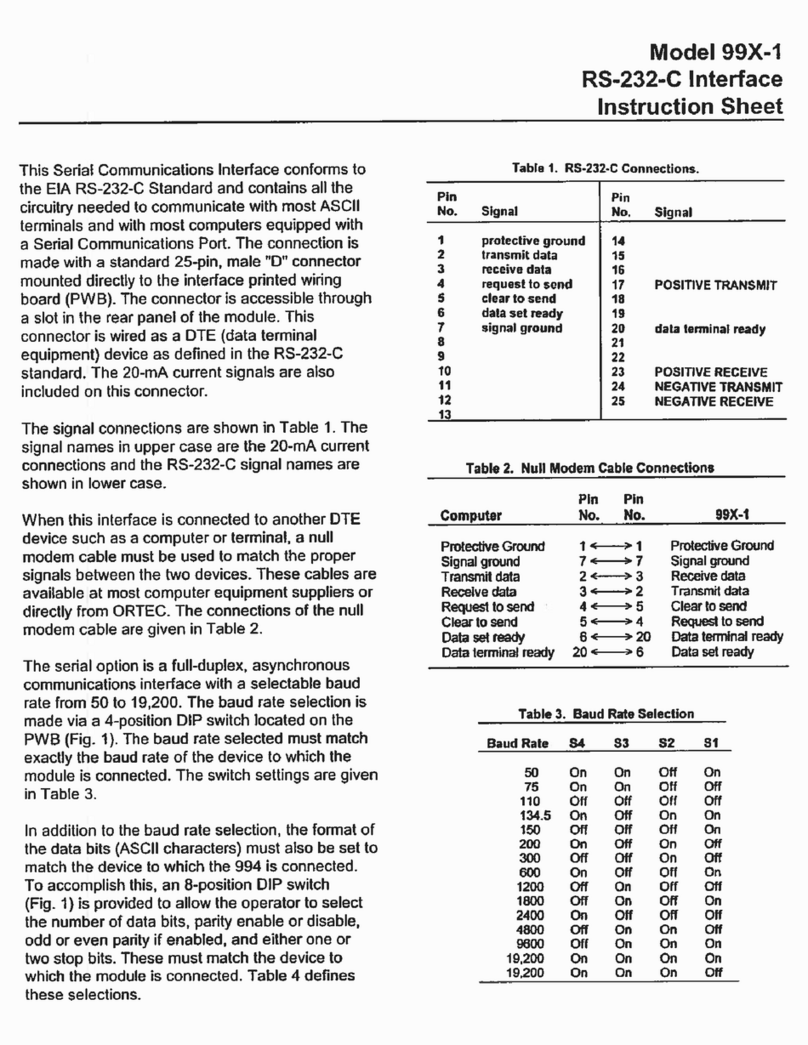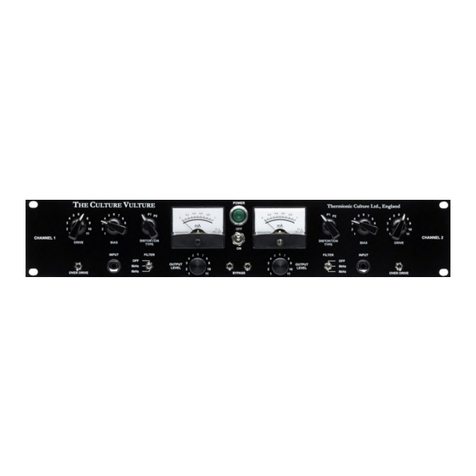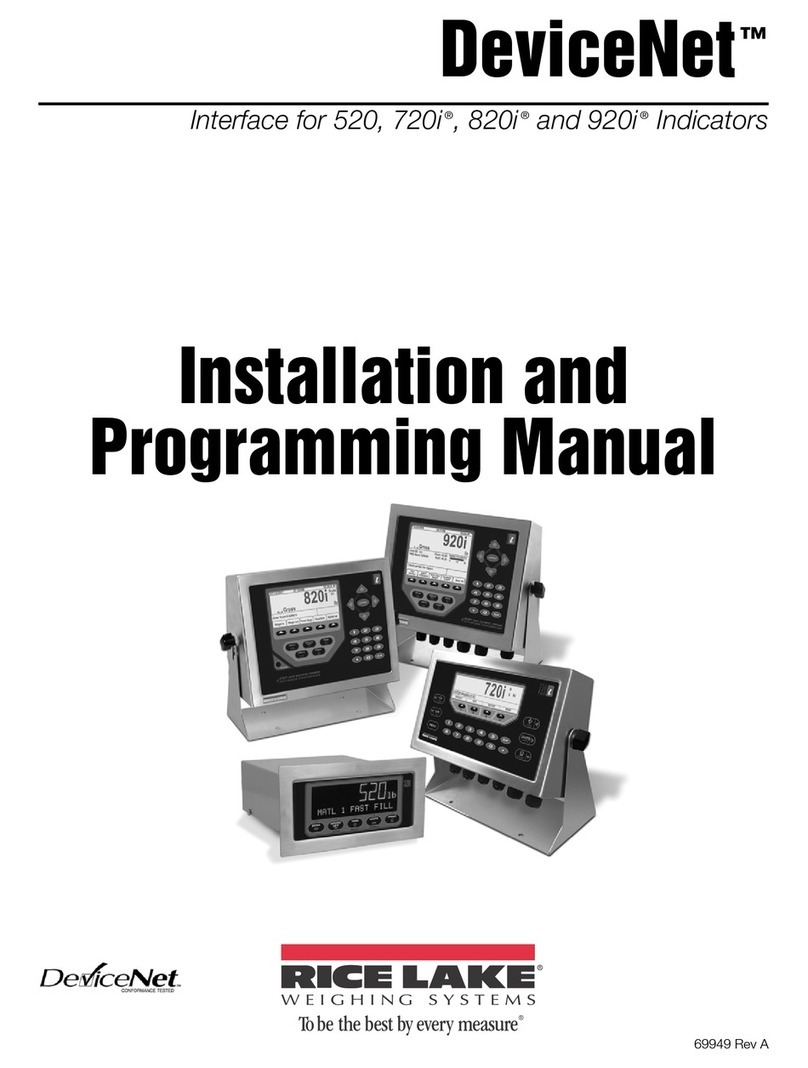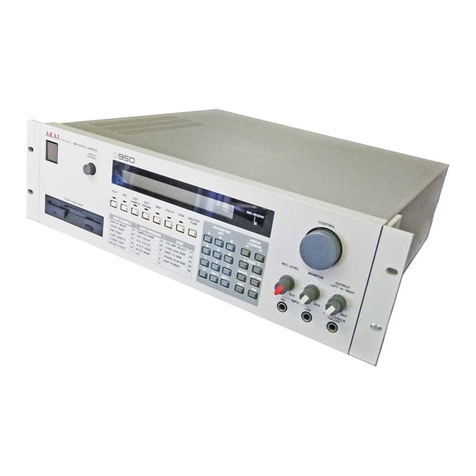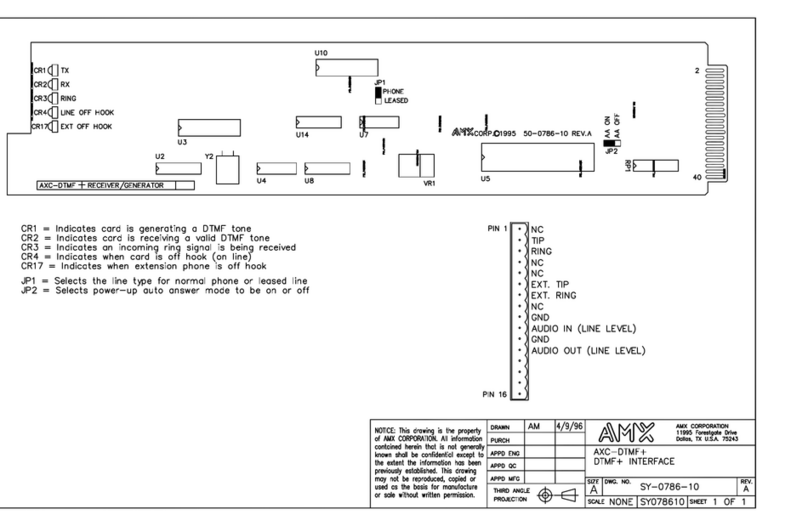RODE Microphones AI-1 User manual

AI-1 SERVICE MANUAL
Spetember 9, 1994
Revision 2.02

PREFACE
This document is intended to assist the service technician in the operation, maintenance and repair of
the AI-1 Digital Interface. This unit represents one of the building blocks of the complete ADAT
system. Together with the AI-1 Reference Manual, this document provides a complete description of the
functionality and serviceability of the AI-1. Any comments or suggestions you may have pertaining to
the document are welcome and encouraged.
WARNINGS
TO REDUCE THE RISK OF ELECTRIC SHOCK OR FIRE, DO NOT EXPOSE THIS
PRODUCT TO WATER OR MOISTURE.
CAUTION
RISK OF ELECTRIC SHOCK
DO NOT OPEN
The arrowhead symbol on a lightning flash inside a triangle is intended to alert the user to
the presence of un-insulated "dangerous voltage" within the enclosed product which may
be of sufficient magnitude to constitute a risk of electric shock to persons.
The exclamation point inside a triangle is intended to alert the user to the presence of
important operating, maintenance and servicing instructions in the literature which
accompanies the product.
REPAIR BY ANY PERSON OR ENTITY OTHER THAN AN AUTHORIZED ALESIS
SERVICE CENTER WILL VOID THE ALESIS WARRANTY.
PROVISION OF THIS MANUAL DOES NOT AUTHORIZE THE RECIPIENT TO COMPETE
WITH ANY ALESIS DISTRIBUTOR OR AUTHORIZED REPAIR SERVICE CENTER IN THE
PROVISION OF REPAIR SERVICES OR TO BE OR MAKE REPAIRS AS AN AUTHORIZED
SERVICE CENTER.
ALL REPAIRS DONE BY ANY ENTITY OTHER THAN AN AUTHORIZED ALESIS
SERVICE CENTER SHALL BE SOLELY THE RESPONSIBILITY OF THAT ENTITY, AND
ALESIS SHALL HAVE NO LIABILITY TO THAT ENTITY OR TO ANY OTHER PARTY
FOR ANY REPAIRS BY THAT ENTITY.
i

SAFETY SUGGESTIONS
Carefully read the applicable items of the operating instructions and these safety suggestions before
using this product. Use extra care to follow the warnings written on the product itself and in the
operating instructions. Keep the operating instructions and safety suggestions for reference in the future.
1. Power Source. The product should only be connected to a power supply which is described either in the operating
instructions or in markings on the product.
2. Power Cord Protection. AC power supply cords should be placed such that no one is likely to step on the cords and such
that nothing will be placed on or against them.
3. Grounding the Plug. This product has a 3-wire grounding type of plug (a plug with a grounding pin) for safety purposes.
This plug can only be used in a grounding power outlet. If the plug does not insert into the outlet you are using, the outlet
probably is not a grounding type of power outlet. Contact your electrician to replace the obsolete outlet with a grounding
type of outlet instead of defeating the safety feature of the grounding type of plug.
4. Periods of Non-use. If the product is not used for any significant period of time, the product's AC power supply cord
should be unplugged from the AC outlet.
5. Foreign Objects and Liquids. Take care not to allow liquids to spill or objects to fall into any openings of the product.
6. Water or Moisture. The product should not be used near any water or in moisture.
7. Heat. Do not place the product near heat sources such as stoves, heat registers, radiators or other heat producing
equipment.
8. Ventilation. When installing the product, make sure that the product has adequate ventilation. Improperly ventilating the
product may cause overheating, which may damage the product.
9. Mounting. The product should only be used with a rack which the manufacturer recommends. The combination of the
product and rack should be moved carefully. Quick movements, excessive force or uneven surfaces may overturn the
combination which may damage the product and rack combination.
10. Cleaning. The product should only be cleaned as the manufacturer recommends.
11. Service. The user should only attempt the limited service or upkeep specifically described in the operating instructions
for the user. For any other service required, the product should be taken to an authorized service center as described in the
operating instructions.
12. Damage to the Product. Qualified service personnel should service the unit in certain situations including without
limitation when:
a. Liquid has spilled or objects have fallen into the product,
b. The product is exposed to water or excessive moisture,
c. The AC power supply plug or cord is damaged,
d. The product shows an inappropriate change in performance or does not operate normally, or
e. The enclosure of the product has been damaged.
ii

DOCUMENT REVISIONS
Revision 1.2 6/23/93 Original Issue
Revision 2.0 2/20/94 Revised entire manual. Added AI-1 QC Test Procedure.
Revision 2.01 4/1/94 Added Parts Order Forms to Appendix D. Revised Table
of Contents. Issued the following change pages:
Title Page, p. iii, p. v, pp. D-4 through D-7
Revision 2.02 9/9/94 Removed Parts Order Forms from Appendix D. Revised
Appendix D (Bill Of Material). Revised Section 1.3.
Revised Section 2.3.1.1. Removed redundant section
3.2.3 and changed it to section 3.2.4. Revised Table of
Contents. Issued the following change pages: Title Page,
pp. iii-v, p. 2, p. 4, p. 8, Appendix D
Revision 2.02 iii 9/9/94

TABLE OF CONTENTS
PREFACE............................................................................................................i
WARNINGS........................................................................................................i
SAFETY SUGGESTIONS.................................................................................ii
DOCUMENT REVISIONS................................................................................iii
TABLE OF CONTENTS ...................................................................................iv
LIST OF FIGURES............................................................................................v
LIST OF TABLES..............................................................................................v
1.0 INTRODUCTION.........................................................................................1
1.1 Scope..............................................................................................................1
1.1.1 Document Conventions ..................................................................1
1.2 AI-1 Reference Manual .................................................................................1
1.3 List Of Abbreviations....................................................................................2
2.0 AI-1 BUILDING BLOCKS..........................................................................3
2.1 AI-1 Power Supply........................................................................................3
2.2 Front Panel PCB............................................................................................3
2.2.1 Front Panel Controls.......................................................................3
2.2.1.1 ADAT Channel Group.....................................................3
2.2.1.2 Destination Rate Group ...................................................3
2.2.1.3 Source and Destination Groups.......................................4
2.3 Main PCB ......................................................................................................4
2.3.1 Main PCB Input/Output..................................................................4
2.3.1.1 ADAT Interface...............................................................4
2.3.1.2 AES/EBU Interface .........................................................5
2.3.1.3 S/PDIF Interface..............................................................5
2.3.2 Main PCB Interconnectivity...........................................................5
3.0 AI-1 REPAIR ................................................................................................6
3.1 AI-1 General Troubleshooting.......................................................................6
3.2 Main PCB Troubleshooting...........................................................................6
3.2.1 AES/SPDIF to AES/SPDIF transfers .............................................6
3.2.2 AES/SPDIF to ADAT transfers......................................................7
3.2.3 ADAT to AES/SPDIF transfers......................................................7
3.2.4 ADAT to ADAT transfers..............................................................8
4.0 AI-1 TESTING..............................................................................................10
4.1 Software Version Check................................................................................10
4.2 AI-1 Self Test Routines.................................................................................10
4.2.1 AI-1 Self Test Setup .......................................................................10
4.2.2 AI-1 Self Test Description..............................................................10
Revision 2.02 iv 9/9/94

APPENDIX A
AI-1 SCHEMATICS ...........................................................................................A-1
APPENDIX B
AI-1 HARDWARE UPGRADES........................................................................B-1
APPENDIX C
AI-1 SOFTWARE HISTORY.............................................................................C-1
Version 1.3...............................................................................................C-2
Version 1.4...............................................................................................C-2
Version 1.5...............................................................................................C-2
APPENDIX D
AI-1 PARTS LIST...............................................................................................D-1
APPENDIX E
AI-1 QC TEST PROCEDURE............................................................................E-1
1.0 Equipment Requirements...................................................................E-2
2.0 AI-1 Self Test ....................................................................................E-2
3.0 AI-1 Interface Test Setup ..................................................................E-4
4.0 ADAT to S/PDIF Interface Test........................................................E-5
5.0 S/PDIF to ADAT Interface Test........................................................E-6
6.0 ADAT to AES/EBU Interface Test ...................................................E-10
7.0 AES/EBU to ADAT Interface Test ...................................................E-12
8.0 Preparation For Delivery ...................................................................E-15
LIST OF FIGURES
Figure 3-1 - AI-1 Signal Flow.............................................................................9
Figure E-1 - Self Test Configuration...................................................................E-3
Figure E-2 - Configuration for AI-1 QC Test Procedure ....................................E-4
LIST OF TABLES
TABLE 4.1 - SELF TEST FAILURES...............................................................11
Revision 2.02 v 9/9/94

1.0 INTRODUCTION
1.1 Scope
This service manual is intended to serve as a primer to assist repair technicians in isolating and
correcting problems associated with the AI-1 Digital Interface. This service manual includes PCB
schematics, PCB comp. IDs., self test routines, and a description of the hardware operation of the AI-1
from a servicing point of view.
1.1.1 Document Conventions
Throughout this service manual, certain conventions are followed in order to make this manual
more coherent. LEDs and signal mnemonics are spelled with all capital letters (such as SOURCE and
SLAVECLK) while functions to be performed by the operator are spelled in bold capital letters (such as
PLAY or REWIND).
1.2 AI-1 Reference Manual
The AI-1 Reference Manual (Alesis P/N 7-51-1071) is included with every AI-1 sold. This
manual explains the basic operation, features, and applications of the AI-1. The manual contains
diagrams of both the AI-1 front panel controls and the rear panel interface. Moreover, the manual
contains several connection diagrams for a variety of recording situations. Please refer to this manual
when information on the operation or connectivity of the AI-1 is required.
1

1.3 List Of Abbreviations
The following is a list of abbreviations to terms used throughout this service manual.
Abbreviation Definition Abbreviation Definition
A Amps (unit of current) LAN Local Area Network
AC Alternating Current LED Light Emitting Diode
AES Audio Engineering Society LRC Little Remote Control
A/D Analog to Digital MHz Mega Hertz (1,000,000 Hz)
ADA Analog/Digital/Analog MIDI Musical Instrument Digital
ADAT Alesis Digital Audio Tape Interface
ADC Analog to Digital Converter MMC MIDI Machine Code
ASIC Application Specific Integrated
Circuit MTC
OSC MIDI Time Code
Oscillator
BRC Big Remote Control PCB Printed Circuit Board
CD Compact Disc PG Phase Generator
D/A Digital to Analog PLCC Plastic Leaded Chip Carrier
DAC Digital to Analog Converter QC Quality Control
DAT Digital Audio Tape RAM Random Access Memory
dB Decibel RMB Remote Meter Bridge
DC Direct Current ROM Read Only Memory
DRAM Dynamic Random Access
Memory S/PDIF
SMPTE Sony/Phillips Digital Interface
Society of Motion Picture and
EBU European Broadcasters Union Television Engineers
EMI Electromagnetic Interference SRAM Static Random Access Memory
EQ Equalization SVHS Super Home Video System
EPROM Erasable Programmable Read
Only Memory S/W
TP Software
Test Point
EEPROM Electrically Erasable
Programmable Read Only
Memory
µs
V
VCA
Microseconds (1/1,000,000 sec)
Volt (unit of voltage)
Voltage Controlled Amplifier
ESD Electrostatic Sensitive Device VLSI Very Large Scale Integrated
FG Frequency Generator Circuit
GND Ground VCR Video Cassette Recorder
H/W Hardware VHS Video Home System
Hz Hertz (unit of Frequency) VCO Voltage Controlled Oscillator
IC Integrated Circuit VU Volume Unit
I/O Input/Output W Watt (unit of power)
Revision 2.02 2 9/9/94

2.0 AI-1 BUILDING BLOCKS
The AI-1 provides a means of interfacing digital audio between the ADAT digital multitrack
recorder and any other digital recording system. The AI-1 converts data from the ADAT format to either
the AES/EBU or S/PDIF interface standards and vice versa. Additionally, the AI-1 is capable of
performing sample rate conversion from 48 KHz to 44.1 KHz and vice versa. With a touch of a button,
any configuration of sending and receiving digital audio is possible, without ever leaving the digital
domain.
Within the AI-1 is a power supply, the Main PCB, and a Front Panel PCB. The Main PCB
connects to the Front Panel PCB via a ribbon cable. A description of each AI-1 building block as well as
the interconnectivity between each building block is presented in the following sections
2.1 AI-1 Power Supply
The power supply is a switching power supply that outputs 5 VDC to the main PCB. A copy of
the schematic is provided in Appendix A. However, there are no serviceable parts within this supply.
Alesis purchases this supply off-the-shelf from an outside vendor. If there is a problem with the power
supply, It is usually less time consuming to replace the whole power supply.
CAUTION: HIGH VOLTAGE. AVOID TOUCHING THE POWER SUPPLY WHEN THE
UNIT IS ON.
2.2 Front Panel PCB
The front panel PCB houses the button pads which cause the LEDs to light up when depressed.
The front panel PCB interfaces to the AI-1 main PCB via a 24-pin ribbon cable. For a description of the
pinout of this cable, refer to Appendix A of this service manual.
2.2.1 Front Panel Controls
The controls on the front panel are classified in four groups: ADAT CHANNEL,
DESTINATION RATE, SOURCE, and DESTINATION. A description of each group is provided in the
following paragraphs.
2.2.1.1 ADAT Channel Group
The ADAT CHANNEL group contains four buttons which are used to select the two ADAT
tracks that will transmit or receive digital audio. Under normal operation, that is when data is being
transferred between the ADAT and an external digital source, only one of the four ADAT CHANNEL
buttons can be enabled at any one time. However, if both the SOURCE and DESTINATION groups are
set to ADAT, all four of the ADAT CHANNEL buttons will be lit, indicating that all eight channels of
the ADAT digital bus are to be transferred.
2.2.1.2 Destination Rate Group
The DESTINATION RATE group provides the operator with the option to change the sampling
rate from 48 KHz to 44.1 KHz or vice versa. However, if the destination of the digital audio signal is the
ADAT, the DESTINATION RATE will automatically default to the 48 KHz sampling rate.
3

Note that the DESTINATION RATE to the ADAT can be set at 44.1 KHz. However, the ADAT
will recognize this sampling rate as a pitch down of -147 cents.
2.2.1.3 Source and Destination Groups
The SOURCE and DESTINATION groups allow the operator to select the configuration that is
being used to transfer the digital audio. Each group contains a button for either ADAT, AES/EBU or
S/PDIF interfaces. Only one of each group's buttons can be pressed at any one time. That is, only one
source and one destination can be selected at any time. If any of the LEDs in either group flash, it
signifies that no device has been selected to receive or send the digital audio.
2.3 Main PCB
The main PCB handles and controls all the various functions of the AI-1. It contains headers
which connect this PCB to the power supply and the front panel PCB as well as numerous input and
output jacks which interface the AI-1 with the outside world.
The main PCB utilizes a CS8411 receiver (U14) and a CS8401 transmitter (U13) to allow the
digital signal to be received and sent respectively. This transmitter/receiver pair also accomplishes the
AES to S/PDIF conversion process based on the operator setup of the AI-1. A DSP56001 digital signal
processor (U38) on the main board accomplishes any sample rate conversion required.
The AI-1 contains the same Audio ASIC (U1) that is used within the ADAT for digital transfer
of data via the Alesis Fiber Optic Interface. The 80C31 micro controller (U9) is used for all of the
clocking and timing within the AI-1 while the EPROM (U10) contains the system software. Finally, an
EEPROM (U41) is used to store the current mode settings of the AI-1. That is, when the AI-1 is
powered on, the unit recalls the most recent mode of operation and lights the appropriate LEDs.
Whenever a change is made to the existing mode settings, the EEPROM is updated to reflect the current
mode settings.
For more information on the Audio ASIC or the Alesis Proprietary Digital Interface, refer to the
ADAT Service Manual.
2.3.1 Main PCB Input/Output
The main PCB contains those connectors which interface the AI-1 with the ADAT, as well as
AES/EBU and S/PDIF protocol devices. The following paragraphs describe the purpose of each type of
connector which is mounted to the main PCB.
2.3.1.1 ADAT Interface
The AI-1 contains two 9 pin D Shell female sync connectors which interface to the ADAT
System. When properly connected to the ADAT or BRC, this interface provides the sample accurate
synchronization with the ADAT system. Moreover, if the BRC is being used to control the ADAT
system in addition to other external equipment, a 48 KHz BNC connector is provided. By connecting the
BRC to the AI-1 through this connector, all clocking is controlled from the BRC. In essence, the BRC
can be used as a master clock for the entire system. The use of a standard "LAN" cable is suggested
when connecting the AI-1 to a BRC
The AI-1 also contains two fiber optic connectors to interface the digital audio to and from the
ADAT. These connectors accept the ADAT fiber optic cable for the transfer of digital data between the
ADAT and the AI-1 using the Alesis Proprietary Digital Interface.
Revision 2.02 4 9/9/94

2.3.1.2 AES/EBU Interface
In order to connect an AES/EBU interface to the AI-1, two XLR jacks are provided. The female
XLR jack is used to receive signals into the AI-1 in the AES/EBU format from external devices.
Likewise, the XLR male jack is used to send signals from the AI-1 in the AES/EBU format to the
connected external device.
2.3.1.3 S/PDIF Interface
In order to connect an S/PDIF interface to the AI-1, two RCA jacks are provided. One of the
RCA jacks is used to receive signals into the AI-1 in the S/PDIF format from external devices and the
other jack is used to send signals from the AI-1 in the S/PDIF format to the connected external device.
Note that the S/PDIF interface to the AI-1 can also be achieved via fiber optic link if the external
device is equipped with this type of interface. The type of connector used in the S/PDIF optical interface
is the same as that used by the ADAT optical interface. However, the protocol of these two interfaces is
different. Therefore, the operator needs to verify the connections when using the optical interface to
ensure that the right cables connect to the appropriate fiber optic connectors on the AI-1.
2.3.2 Main PCB Interconnectivity
The main PCB is connected to the front panel via a 24 wire ribbon cable and to the power supply
by a 3-pin SIL connector. The colored stripe of the ribbon cable must be on the left side of the header
when the operator is facing the AI-1 front panel. The 3-pin SIL connector contains a brown and a blue
wire. The brown wire goes to +5V and the blue wire goes to ground. If for some reason the AI-1 does
not power up, these cable connections should be the first things to check when troubleshooting.
5

3.0 AI-1 REPAIR
The following paragraphs represent some of the more common AI-1 related problems as well as
recommended solutions. To assist the service technician in the troubleshooting and repair of the AI-1,
schematics and comp ID's for all of the PCBs are provided in Appendix A of this service manual.
3.1 AI-1 General Troubleshooting
Problems which arise on the main PCB may affect the performance of the unit. However, two of
most common problems relate to the absence of audio sent to the destination unit and distortion of the
audio signal. Prior to the start of any troubleshooting, first check to see if the unit passes its self-test.
Additionally, a visual inspection of the unit should always be completed in any troubleshooting process.
Finally, check to see if all cables are properly plugged into their respective jacks. A description of the
AI-1 self tests is provided in section 4 of this service manual.
There are two quick ways of troubleshooting units with no audio. First, check to see if any of the
LEDs in the DESTINATION group are flashing. As explained in section 2.2.1.3, this flashing indicates
that the function selected does not match that of the actual destination unit. Depress the appropriate LED
in the DESTINATION group, and the flashing should cease. Moreover, the flashing LED may also
indicate that no sample rate has been chosen. If this is the case, select the appropriate sample rate.
Distortion is usually caused by a problem in the reception of the audio signal. A visual
inspection of the board may solve this problem. Check for any solder bridges or any open/cut traces
along those IC components that have an effect on the transmission or reception of the signal. Also,
verify that the pins of these components make contact with their respective pads. Depending on the
configuration selected to send and receive the digital audio, each troubleshooting process will be
different. Refer to section 3.2 for more details on specific troubleshooting
3.2 Main PCB Troubleshooting
The following is a list of the most likely components to evaluate when troubleshooting the main PCB.
−DSP56001 (U38)
−AUDIO ASIC (U1)
−80C31 (U9)
−EPROM (U10)
−CS8401 TRANSMITTER (U13)
−CS8411 RECEIVER (U14)
−DS8922 DRIVER (U28)
A better understanding of how each IC component operates within the AI-1 is described in the
following sections.
3.2.1 AES/SPDIF to AES/SPDIF transfers
In this scenario, the digital source is an external device using the AES/EBU or S/PDIF interface
standard. Likewise, the destination is also an external device using either the AES/EBU or S/PDIF
interface. The sampling rate for this scenario can be either 48 KHz or 44.1 KHz. Refer to figure 3-1 for a
pictorial representation of this scenario.
6

When the AI-1 is used in this configuration, digital data is routed from the external device via
the AES/EBU or S/PDIF interface to the AI-1's respective input jacks. Next, this signal is routed into the
CS8411 receiver chip (U14), and then into the DSP56001 (U38) chip if any sample rate conversion is
required. Once the sample rate conversion is complete, the signal is then routed through the CS8401
transmitter (U13) to the AI-1's respective output jacks (either AES/EBU or S/PDIF) and finally is
received by the destination unit.
If the S/PDIF optical input is used, the AI-1 will first convert the optical data to electrical signals
prior to routing it through to the receiver chip (U14). Conversely, if the S/PDIF optical output is being
used, the AI-1 will convert the data routed out of the transmitter chip (U13) to the S/PDIF optical
format. The S/PDIF optical converters are designated as J11 on the AI-1 schematic.
The CS8401 and CS8411 chips perform all of the AES/EBU and/or S/PDIF data conversion if
required. The micro controller (U9) is used to select the appropriate protocol to be used by each device,
based upon the configuration set up on the AI-1 front panel.
3.2.2 AES/SPDIF to ADAT transfers
In this scenario, the digital source is an external device using the AES/EBU or S/PDIF interface
standard. However, the destination is an ADAT. The sampling rate for this scenario can be either 48
KHz or 44.1 KHz at the source but must be set to 48 KHz for input to the ADAT. Refer to figure 3-1 for
a pictorial representation of this scenario
When the AI-1 is used in this configuration, digital data is routed from the external device via
the AES/EBU or S/PDIF interface to the AI-1's respective input jacks. This signal is then routed to the
CS8411 Receiver (U14), and then into the DSP56001 (U38) chip if any sample rate conversion is
required. Once the sample rate conversion is complete, the signal is routed to the Audio ASIC (U1) via
the ASIC's ADC inputs (pins 60, 61, 66 and 67). The Audio ASIC converts the signal into the ADAT
digital format. The output of the ASIC (signal: DIGOUT) is converted to light via the fiber optic
converter J5, and directed to the ADAT via the Alesis fiber optic digital interface.
If the S/PDIF optical input is used, the AI-1 will first convert the optical data input via J11 to
electrical signals prior to routing it through to the receiver chip (U14).
The CS8411 chip performs all of the AES/EBU and/or S/PDIF data conversion if required. The
micro controller (U9) is used to select the appropriate protocol to be used by each device, based upon
the configuration set up on the AI-1 front panel.
3.2.3 ADAT to AES/SPDIF transfers
In this scenario, the digital source is an ADAT while the destination is an external device using
the AES/EBU or S/PDIF interface standard. The sampling rate for the ADAT must be 48 KHz but can
be set to either 48 KHz or 44.1 KHz for the destination device. Refer to figure 3-1 for a pictorial
representation of this scenario
When the AI-1 is used in this configuration, digital data in the Alesis optical format is routed
from the ADAT to the AI-1 via the fiber optic converter J5. After conversion from the optical format to
electrical signals, the data is routed into the Audio ASIC (signal: DIGIN). The signal is then routed
through the DAC outputs of the ASIC (pins 56-59 and 68-71) into the DSP56001 (U38) chip if any
sample rate conversion is required. Once the sample rate conversion is complete, the signal is then
routed through the CS8401 transmitter (U13) to the AI-1's respective output jacks (either AES/EBU or
S/PDIF) and finally is received by the destination unit.
7

Revision 2.02 8 9/9/94
If the S/PDIF optical output is used, the AI-1 will first convert the electrical data to optical
signals prior to routing it out of the optical output via J11 to the destination.
The CS8401 chip performs all of the AES/EBU and/or S/PDIF data conversion if required. The
micro controller (U9) is used to select the appropriate protocol to be used by each device, based upon
the configuration set up on the AI-1 front panel.
3.2.4 ADAT to ADAT transfers
In this scenario, the digital source and destination is an ADAT. The sampling rate for the ADAT
must be 48 KHz at both the source and destination. Refer to figure 3-1 for a pictorial representation of
this scenario.
When the AI-1 is used in this configuration, digital data in the Alesis optical format is routed
from the ADAT to the AI-1 via the fiber optic converter J5. After conversion from the optical format to
electrical signals, the data is routed into the Audio ASIC (signal: DIGIN). The output of the ASIC
(signal: DIGOUT) is converted to light via the fiber optic converter J5, and directed to the destination
ADAT via the Alesis fiber optic digital interface.
Note that if both the SOURCE and DESTINATION groups are set to ADAT, all four of the
ADAT CHANNEL buttons will be lit, indicating that all eight channels of the ADAT digital bus are to
be transferred. This is identical to accomplishing a direct transfer of data between ADATs. Refer to the
ADAT reference manual for details.

Figure 3-1 - AI-1 Signal Flow
9

4.0 AI-1 TESTING
Every AI-1 under repair must be fully tested prior to its shipment back to the customer.
Appendix E contains the test procedure which should be conducted on every AI-1 serviced.
Furthermore, within the AI-1 software are a number of self test routines which can be implemented to
aid in determining various problems with the unit. A description of these test routines is listed in the
following sections.
4.1 Software Version Check
There is a method of checking which version of software is installed in the AI-1 from the front
panel. To accomplish this, simply press the ADAT CHANNEL 1/2 and DESTINATION S/PDIF
buttons simultaneously while applying power to the unit.
The software version is displayed via lighted LEDs on the front panel in the format (X.Y). To
interpret the correct version of software, follow the guidelines below.
The front panel is separated into two groups of six LEDs: the left group (containing the ADAT
CHANNEL and DESTINATION RATE LEDs) and the right group (containing the SOURCE and
DESTINATION LEDs). The number of LEDs lit on the left group indicate the X, while the number of
LEDs lit on the right group indicate the Y.
As an example, suppose that version 1.5 software is installed in the AI-1. When the operator
presses the ADAT CHANNEL 1/2 and DESTINATION S/PDIF buttons simultaneously while
applying power to the unit, the AI-1 front panel display will light several LEDs. For version 1.5
software, the left group of LEDs will only light one LED while the right group of LEDs will light 5
LEDs.
4.2 AI-1 Self Test Routines
The AI-1 self-test is designed to identify the most common symptoms which may hinder the
unit's performance. It can also be used as an aid in locating the area where the problem originates. The
AI-1 self test is accomplished automatically once initiated by the operator and will only work properly if
all of the connections listed in section 4.2.1 are made prior to initiating the self test routine.
4.2.1 AI-1 Self Test Setup
To conduct the self test, connect the following cables and equipment to the AI-1 as detailed below:
1. Connect an RCA cable from the S/PDIF Input RCA jack to the S/PDIF Output RCA jack.
2. Connect a DB9 cable from the Sync In jack to the Sync Out jack
3. Connect an XLR cable from the AES/EBU Input jack to the AES/EBU Output jack.
4. Connect an optical cable from the S/PDIF Input Optical jack to the S/PDIF Output
Optical jack.
5. Connect another optical cable from the ADAT In jack of the AI-1 to the Digital
Output jack of the ADAT. (NOTE: The AI-1 self tests can be conducted without the
use of an ADAT. However, some of the self tests will fail.)
4.2.2 AI-1 Self Test Description
To begin the AI-1 self test, press and hold the ADAT CHANNEL 1/2 and SOURCE S/PDIF
buttons simultaneously while applying power to the AI-1.
The first test executed by the AI-1 is the LED test. During this test, the AI-1 will light up vertical
pairs of LED's from left to right. It will do this 2 times. The operator is then able to verify the proper
10

operation of all of the LEDs on the AI-1 front panel. If any of these LEDs do not light, then there is a
most likely a problem with the LED itself.
The second test is a switch test. After the LEDs turn off, the operator can press a button to verify
its proper operation. If the button pressed is functional, its LED will toggle on and off. In this manner,
all the function buttons can be tested.
Finally, the Input/Output and other function tests will occur. To execute this test, the operator
must once again press the ADAT CHANNEL 1/2 and SOURCE S/PDIF buttons simultaneously. A lit
LED indicates a pass and an unlit LED indicates a fail. For all test failures, first check all connections
and make sure there are no solder bridges along those components in question. If none of these
recommendations resolve the problem, Table 4.1 lists other possible causes for the test failure which
corresponds to the LED that is unlit.
TABLE 4.1 - SELF TEST FAILURES
AI-1 Front Panel LED unlit Failed Test Probable Cause of Failure
ADAT Channel 1/2 EEPROM (U41) 80C31 Micro controller (U9), it's socket, or the
EEPROM (U41).
ADAT Channel 3/4 SRAM (U18, U19) SRAM (U18, U19), DSP56001 (U38), or 80C31
Micro controller (U9)
ADAT Channel 5/6 MIDI MIDI DB9 connectors,
opto-isolators (U34, U37)
or 80C31 Micro controller (U9)
ADAT Channel 7/8 DSP56001 (U38) DSP56001 (U38)
or 80C31 Micro controller (U9)
48 KHz Checksum EPROM (U41)
or 80C31 Micro controller (U9)
44.1 KHz None. Should always be lit
Source ADAT ADAT Input circuitry Optical connector, Audio ASIC (U1), Digital or
Sample VCO's
or 80C31 Micro controller (U9). NOTE: If no
ADAT is connected to the AI-1, this test will always
fail.
Source AES/EBU AES/EBU circuitry XLR jacks, DS8922 driver (U28), CS8401
transmitter (U13), CS8411 receiver (U14),
DSP56001 (U38)
or 80C31 Micro controller (U9)
Source S/PDIF S/PDIF RCA jacks RCA jacks, DS8922 driver (U28), CS8401
transmitter (U13), CS8411 receiver (U14),
DSP56001 chip (U38)
or 80C31 Micro controller (U9)
Destination ADAT None. Should always be lit
Destination AES/EBU None. Should always be lit
Destination S/PDIF S/PDIF Optical jacks Optical connector, DS8922 driver (U28), CS8401
transmitter (U13), CS 8411 receiver (U14),
DSP56001 (U38)
or 80C31 Micro controller (U9)
11

APPENDIX A
AI-1 SCHEMATICS
A-1

APPENDIX B
AI-1 HARDWARE UPGRADES
B-1

APPENDIX C
AI-1 SOFTWARE HISTORY
C-1
Other manuals for AI-1
2
Table of contents
Other RODE Microphones Recording Equipment manuals


